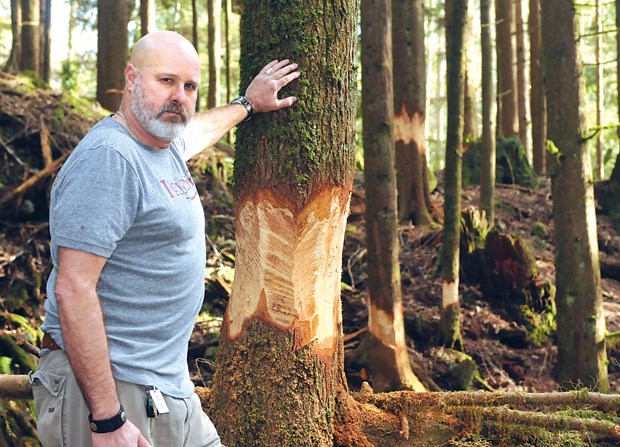Upper Delbrook residents and District of North Vancouver staff are left with unanswered questions after BC Hydro crews “ringed” more than 100 trees along Mosquito Creek.
Melanie Rockhill first noticed the dozens of trees that had been cut with chainsaws when she was walking her dog along the nearby trail where it meets the Baden Powell Trail on Feb. 19.
By severing the bark around the tree, nutrients can no longer flow up from the root system, effectively killing the tree, though it make take several months for the foliage to fall off.
Melanie said her reaction was one of “shock and horror.”
“I’m a huge advocate of maintaining trees and the forest and the environment,” she said. “And I was sickened because I know what that is. I know what the ringing of trees does. I was horrified, especially at the quantity. There were so many. It wasn’t half a dozen.”
More than the loss of some beloved trees, Melanie and her husband Derrick are worried about the impact on the surrounding environment and trail.
“We live off the creek as well. We’re quite concerned because there’s been floods in the past and these trees were cut right down to the edge of the creek. Over time, that’s going to cause erosion when these trees are gone,” said Derrick, adding “There’s no way any professional person would actually ring a tree like that just to rot and fall on people. That’s a hiking trail.”
While the land is owned by the District of North Vancouver, BC Hydro has a right of way and mandate to manage the vegetation under its transmission lines for safety, according to Richard Boase, environmental protection officer. But the Rockhills’ concerns, as well as a host of others, are ones shared by district staff who say they were not given any prior warning by BC Hydro.
“We have a whole number of items that we’ve invited Hydro to sit and meet with us on for further discussion around their choice of this particular methodology. Did they have the information the district has regarding the various nature and sensitive areas in and around the creek? Boase said. “This particular site is subject to wildfire protection, slope hazards, creek hazards, and streamside protection. Those are the issues we would have liked to have had the chance to have dialogue around the work before it takes place.”
Responding to a request for an interview, BC Hydro spokeswoman Mora Scott sent a statement saying the decision to ring or “girdle” the trees was made in order to retain as much cover as possible.
“A biologist, forester and certified arborist surveyed the area and determined, after careful consideration, that girdling was the best prescription to treat the trees that were at risk of growing into our power lines,” she said. “There is less impact on the stream as the canopy opens up gradually to more sunlight and it provides site stability on steeper slopes because the root structures of the trees are maintained for longer periods of time than full tree removal.”
Beyond that, girdling increases low-growing forage for wildlife and provides habitat for small mammals and birds, and creates a wildlife tree that can be used by woodpeckers, squirrels and bats, Scott said.
Only coniferous trees were determined to be a risk and deciduous ones were left to grow, Scott said. Topping trees would have, over time, posed more of a risk to hikers, she added.
“Our staff patrol the power lines twice a year and will closely monitor these trees and remove any girdled trees that pose undue risk to public safety,” Scott added.



